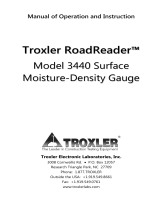
RADIATIONSENSORML69M
USER’SGUIDE
CENTRE FOR MICROCOMPUTER APPLICATIONS
http://www.cma-science.nl

2|ML69mRadiationSensorUser’sGuide
Shortdescription
TheRadiationsensorML69msensesalpha,betaandgammaradiation.
Alpha,beta,gammaradiationionizematerial theystrikeorpassthrough.Theamount
of radiation is generally determined by measuring the resulting ionization. The
Radiation sensor uses a Geiger‐Müller tube to detect this radiation. The GM tube
consistsofan
anode(positiveelectrode)pos itionedinthecenterofa tubularcathode
(negativeelectrode)filledwithamixtureofneonandhalogen.Thecathodeisathin‐
walledmetalliccylindersealedat eachendwithaninsulatingdisktocontainthegas.
The anode is a wire that extends into the
cylinder. A high voltage is applied to the
electrodes to create an electrical field within the chamber. When radiation passes
throughthechamberandionizesthegas,itgeneratesapulseofcurrent.Thesensor
electronically processes these pulses to display the radiation level in counts per
minute.Aclickingsound
isemittedforeachdetectedradiationevent(foreachcount).
TheendoftheGMtubehasathinmicawindow.Itallowsalphaparticlesto reachthe
GMtubeandbedetected.Themicawindowwillalso senselowenergybetaparticles
andgammaradiationthatcannotpenetratetheplastic caseorthesideofthetube.
Fortheshortamountoftime theGMtubeisdetectingoneparticle,itisnotableto
detectanotherradioactiveparticleifitentersthetube.Thisiscalledthesensor’sdead
time.ThemaximumdeadtimefortheGMtubeis90microseconds(or90μs).
Todetectradiation,pointthesensortowardthesourceofradiation.Todetectalpha
radiation put the sensor close to the source, this is because alpha particles do not
travelfarthroughair.
The Radiation sensor is an I2C digital sensor, which gives calibrated values of the
measured quantity. This sensor can only be connected to special interfaces that
supportI2CdigitalsensorsliketheCMAMoLabinterface.
Sensorspecifications
Radiation sensor ML69m is a digital sensor that converts the number of counted
detectedpulsestoadigitalvalueofcountsperminute.Themaximalsamplingrateof
thesensoris1Hz.
Collectingdata
This Radiation sensor works only with specific interfaces. The sensor will be
automaticallydetectedwhenconnectedto suchaninterface.Fordetailedinformation
aboutmeasurementswithsensorsconsulttheUserManualsoftheinterfaceandthe
Coach6software.

ML69mRadiationSensorUser’sGuide |3
Calibration
TheRadiationsensorissuppliedwithafactorycalibrationincountsperminute(cpm).
TheCoach 6 program allows shiftingthe pre‐defined calibration if needed. The user
calibrationisstoredinnon‐volatileusersensormemory.
Suggestedexperiments
1. Monitoringbackgroundradiation
If the radiation sensor is set up far away from any radioactive sources, it still
detectspulsesoccasionally.Thisisdueto thebackgroundradiationthatisaresult
of radiation that occurs naturally from cosmic radiation, geophysical radiation,
inherent material radiation, etc. Normal background radiation levels
vary at
different locations, according to altitude and other factors, such as types of
mineralsintheground.Thelevelofbackgroundradiationisusuallyverylow.
Sincethebackgroundradiationispresentinallexperiments,itshouldbemeasured
andsubtractedfromtheexperimentalreadingsforthesetobe
reliable.
2. Monitoringradiationofcommonradioactivematerials
Herethenaturalsourceofradiationsuchas potassiumsaltsorlanternmantelscan
be used.In such experiments the random nature of the radiation can be
presented.
3. Radioactivedecayandhalf‐lifedetermination
The radiation sensoroffers thepossibility to measure
radioactive decay rate and
half‐life time. In such experiments isotope generators, like a Protactinium
generator(withahalf‐lifetimeof72seconds)oraBa137mg enerator(withahalf‐
lifetimeof153seconds)areidealradioactivesourcesfortheseexperiment.
4. Radiationlevelversusshielding
In this
experiment the radiation level is recorded when absorbers of different
thickness are placed between the sensor and radiation source. As absorber an
aluminumsheet(s)forbetaradiationoraleadsheet(s)forgammaradiationcanbe
used. In this experiment you can also compare the effect of different types of
materials
toshieldalpha,betaorgammaradiation.
5. Monitorradiationfromanalpha,betaorgammaradiationsourceasafunctionof
thedistancebetweenthesourceandtheradiationsensor
In this experime nt the radiation level is recorded when a sensor is placed at
differentdistancesfromtheradiation
source.

4|ML69mRadiationSensorUser’sGuide
TechnicalSpecifications
Sensorkind Digital16‐bitsresolution
(on‐sensordigitalconversion)
communicationviaI2C
Sensitiveto Alpha,beta,gammaradiation
Measuringrange 0..20,000countsperminute
Resolution 1countperminute
Accuracy
Typical±10%at25℃
Maximalsamplingrate
1Hz
Temperaturerange
0‐50℃
GMtube Neon‐HalogenquenchedGM‐tube
Cathodematerial
446StainlessSteel
Cathodewallthickness 0.25mm
Micawindow
Effectivediameter9.1cm
Arealdensity1.5–2.0mg/cm
2
Gammasensitivity
ReferencedtoCobalt60
18cps/mr/hr
Operatingvoltage 500V
MinimumDeadTime 90μs
Audiooutput Clickingsoundforeachcount
Connection 5‐pinsminijackplug
Warranty:
The Radiation sensor ML69m is warranted to be free from defects in materials and
workmanshipfor a periodof12months fromthedateofpurchaseprovidedthatithas
been used under normal laboratory conditions. This warranty does not apply if the
sensorhasbeendamagedbyaccidentormisuse.
Note:Thisproductisto beusedforeducationalpurposesonly.Itisnotappropriatefor
industrial,medical,research,orcommercialapplications.
Rev. 10/06/2012
/
